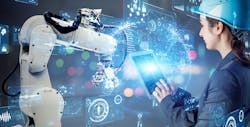Craftsmanship Transcends Space and Time
Manufacturing will exist as long as people need goods. But manufacturing in 2070 will in some ways mirror, and in other ways differ from, manufacturing today because of significant innovations in AI, computer vision, robotics and material science.
In 2070, there will be two commercially viable manufacturing options: centralized and distributed.
For big-ticket products like cars, economies of scale will continue to require centralized manufacturing. AI and computer vision will guide the line associate (yes, there will still be many humans in plants!), and drive standardized work adherence, quality, training, etc.
But, growing demand for personalization will drive mass customization and delivery at your neighborhood “PrintEx,” powering the rise of distributed manufacturing. For example, the customer will select a pair of eyeglasses from Warby Parker’s website, be measured by his computer scanner, customize them and have them printed at the local “shop” on demand.
The secret sauce lies in AI transforming the humble store clerk—with no prior knowledge of Toyota Production System—who is charged with manufacturing eyeglasses one moment and toy trucks the next, into a master craftsperson. Simply because it has learned and transferred the knowledge of many master craftspeople in factories to our store clerk somewhere else on the planet and helped him safely deliver a pair of quality glasses.
What will remain unchanged over the next 50 years is the presence of humans and the importance of craftsmanship. People want to buy quality products inexpensively. Without craftsmanship, the line and store associates simply cannot deliver to the customer’s expectations. Marrying human and artificial intelligence smartly will democratize craftsmanship.
Prasad Akella is founder and CEO of Drishti, a company deploying AI to collaborate with and enhance humans on the factory floor. He led the industry/university team that built the world’s first collaborative robots (cobots) at GM .